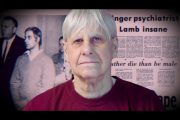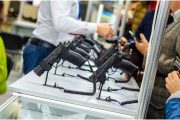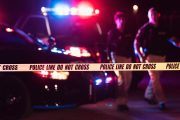Will Timothy McVeigh, like O.J. Simpson, walk out of court a free man? Will the perpetrators of “the deadliest terrorist attack on American soil,” like the slayer of Nicole Brown Simpson and Ron Goldman, get away with murder? If so, it will be thanks to “incompetence” and “stupidity” so extreme on the part of federal investigators and prosecutors as to defy belief.
With the Oklahoma City bombing trial only weeks from beginning, the once “airtight” case against suspects Timothy McVeigh and Terry Nichols began unraveling so rapidly during the last week of January that it appeared to have gone into terminal meltdown. Almost simultaneously, one of the prosecution’s key eyewitnesses suddenly changed his story, and the FBI’s already-suspect crime lab came under open fire for mishandling evidence from the bombing. Perhaps even more important, however, were the arrests in Pennsylvania of two neo-Nazis whom this reporter and other investigative journalists have been tracking for over a year as prime “John Doe” suspects in the bombing. For some inexplicable reason, the FBI and the ATF — which have been in hyperactive mode arresting militia members all across the country on flimsy charges and trumped-up evidence — have been conspicuously and obstinately resistant to the genuinely compelling evidence connecting McVeigh and the Oklahoma City bombing to these individuals. The fact that they were arrested on supposedly unrelated bank robbery charges shortly before the bombing trial has led to suspicions that they were being “taken out of circulation” before they could be subpoenaed by a new grand jury or the survivors of bombing victims who have named them as co-defendants in a civil suit.
Bureau Under Fire
Longstanding accusations by a top FBI scientist of shoddy lab practices as well as outright fraud and evidence-tampering at the nation’s premiere crime-fighting laboratory became a headline story during the period of January 28th-30th. “Trouble in the FBI Lab,” blared the title of a lead New York Times editorial. “Workers Portray FBI Lab as a Shoddy Shop,” declared a Los Angeles Times headline. “Pattern of Lies at FBI’s Lab?” asked a Sacramento Bee story heading. On January 30th, ABC’s Nightline program weighed in with a hard-hitting piece entitled “The FBI Crime Lab in Crisis,” which featured an interview with Dr. Frederic Whitehurst, a senior FBI special agent whose charges of misconduct at the lab are at the center of the controversy.
Whitehurst, who was the FBI’s top chemist in explosives analysis and had been described in an evaluation by superiors as “without peer in the FBI bomb residue analysis unit,” has suffered the fate of many whistleblowers. After years of futile complaining through official channels about practices that were seriously compromising the lab’s work, in 1995 Dr. Whitehurst went public with accusations of routine mishandling and falsifying of evidence, cover-up, and perjury by senior FBI lab personnel. The FBI chemist’s allegations directly affect the Oklahoma bombing case and have resulted in the removal from the crime lab of three senior FBI agents who had major responsibilities in the Oklahoma bombing investigation and were expected to be crucial expert witnesses.
On January 27th, the FBI announced that the three officials would be transferred to other work. They were later identified as: David Williams, supervisory agent in the explosives division; James T. Thurman, chief of the lab explosives division; and Roger Martz, chief of the chemistry and toxicology division. Although these three were merely transferred, Dr. Whitehurst was, on the same day, suspended and required to turn in his gun and badge.
An angry Senator Charles Grassley (R-IA), who chairs the subcommittee which oversees the Justice Department and FBI, was prompt to charge that the suspension appeared to be “a reprisal” against White hurst for his courageous actions. “The action taken by the FBI implies that he is being punished for ‘committing truth,'” said Grassley. “It appears to be a reprisal for his disclosures.”
Grassley declared that “there’s been too much covering up by the FBI for too long,” and accused the agency of “seeking to shoot the messenger instead of fixing the problem.”
Whitehurst was subpoenaed by the defense attorneys for McVeigh and Nichols for a deposition last December and is expected to be called as an expert witness for the defense. FBI chemist Mary Tungol and FBI lab examiner Brett Mills were also deposed and are among a reported 37 witnesses who support Whitehurst’s allegations. Although those depositions remain sealed, defense attorneys, in a legal filing last September, stated: “Dr. Mary Tungol has stated that she believes that evidence taken from … McVeigh’s car was contaminated. Brett Mills … has stated that an area in the FBI Laboratory that was used to store evidence collected … in this case was contaminated with PETN.” This could be highly significant testimony since some of the strongest forensic evidence purportedly linking McVeigh to the truck bomb is the PETN detonator cord residue that FBI lab reports say was on his knife, knife sheath, and clothing.
“Pattern” of Corruption
Even more disturbing are allegations from Steven Burmeister, a chief analyst in the lab’s chemistry and toxicology division, who was quoted in the Los Angeles Times as saying that the lab “knowingly” has sent out false reports and that the lab’s explosives unit has been “stretching the truth for years.” Such accusations of intentional misconduct strike more to the heart of the most serious of Dr. Whitehurst’s charges. In his testimony to the Justice Department’s Inspector General, the FBI whistleblower reportedly repeated his earlier charges of being pressured to prove guilt rather than just test evidence. He said there was a “pattern” in high-profile cases of lab personnel testifying in court on areas beyond their level of expertise, and of his own lab reports being changed by others in order to help prosecutors get convictions.
Among those who allegedly changed Whitehurst’s test results are David Williams and James Thurman. This, together with the admissions that evidence from the Oklahoma bombing under Williams’ and Thurman’s supervision was badly mishandled, has disqualified them as “expert” witnesses for the prosecution.
Besides challenging the evidence-gathering procedures and the crime lab’s findings, McVeigh’s defense attorney, Steven Jones, is likely to impugn the FBI’s competence and integrity by asking, as he did in a Nightline interview, why the FBI did not send Whitehurst, its top explosives chemist, to Oklahoma City, rather than Williams, to collect and examine the evidence from this “worst ever” U.S. terrorist bombing.
Justice Department officials have admitted that the crime lab revelations could affect hundreds of important cases and lead to appeals of many previous convictions. The FBI’s famed Washington, DC laboratory, with an annual budget of $64 million and over 500 employees, conducts some 600,000 examinations per year, about half of which involve analyzing evidence for state and local law enforcement. Critics have been pointing out for some time, however, that the vaunted laboratory has fallen behind standards and technology employed in many state laboratories. More importantly, the Whitehurst allegations, together with the recent “Filegate” scandal involving the Clinton Administration’s blatant and illegal use of FBI files against political “enemies,” demonstrate some of the obvious dangers inherent in the alarming trend toward nationalizing and centralizing police powers which under the Constitution are reserved to state and local governments.
Change of Heart?
Equally important to the Oklahoma bombing case as the crime lab scandal is the recent impeachment by the federal prosecutors of one of their own star witnesses against Timothy McVeigh. In court papers unsealed on January 29th, federal officials stated that the circulation of a sketch of the still at-large John Doe No. 2 was based on a mistake by an eyewitness at the Ryder truck rental agency in Kansas where McVeigh is charged with obtaining a truck used for the bombing. The document’s release was a formal assertion of the prosecution’s “lone bomber” position first floated in June 1995. At that time, prosecutors stated that the John Doe No. 2 suspect had probably been the result of confusion by witnesses at the rental agency who had mistakenly associated McVeigh with another man who rented a truck the day after McVeigh had visited their office.
According to prosecutors, the sketch was based on a description provided by Tom Kessinger, an employee at the truck rental office in Junction City, Kansas. Now, say the officials, Kessinger agrees that he was mistaken in earlier recalling a second man with McVeigh, who reportedly registered for the truck under the name “Robert Kling.” The sketch, goes the revised story, was really that of Army Private Todd Bunting, a soldier at nearby Fort Riley, who came in on April 18th, the day after McVeigh, and who had no connection to the bombing. Kessinger has not been available for interviews.
The government appears so insistent on pushing its ludicrous lone-bomber theory — with Terry Nichols providing only peripheral help to McVeigh — that it is willing to jeopardize the entire case rather than admit the compelling evidence and numerous credible eyewitnesses who attest to seeing McVeigh with a man resembling the John Doe No. 2 sketch, as well as additional John Does, on the fatal morning of April 19, 1995, and on the days leading up to it.
A major problem for the prosecutors is that Kessinger had previously gone on record in opposition to their Todd Bunting story. Glenn Wilburn, whose two young grandsons were murdered in the explosion, traveled to Junction City last year to see Kessinger. Wilburn told THE NEW AMERICAN recently that when he sat in Kessinger’s home to discuss the matter there was “no question” about the witness’ certainty at having seen the John Doe No. 2 suspect. “My exact words,” recalled Wilburn, “were ‘Well, tell me about the Todd Bunting deal. Was there any way you could have had any confusion about that?’ And he [Kessinger] laughed, and then I chuckled and said, ‘That was pretty ridiculous, wasn’t it?’ And he said ‘Yeh, I don’t know where they came up with that.'”
Blowing the Case
This last-hour switching of testimony fits a disturbing pattern that has become all too familiar in the case. Three weeks prior to Kessinger’s flip-flop, another key prosecution witness in Junction City also damaged his credibility by changing his testimony. Tom Manning, a used-auto dealer who sold McVeigh the Mercury in which the bombing suspect was arrested, stated in testimony released in early January that McVeigh had left his presence for 10 to 15 minutes. This absence is significant because it fits the prosecution’s timeline which holds that McVeigh left to place calls to Terry Nichols and the truck rental agency. Thus McVeigh’s absence neatly matches with calls on his telephone calling card records.
The problem is that in 11 previous affidavits Manning had not recalled this absence, and defense lawyers have already compellingly made the point that Manning’s “new” contention appears to have been prodded by prosecutors and will make his testimony suspect. Other important witnesses have reported being pressured by FBI investigators and prosecutors in attempts to get them to change their testimony. And the many eyewitnesses who continue to insist that they saw additional John Does are being conspicuously excluded from the prosecution’s trial witness lineup. “They’re risking blowing the case to cover up at any means,” said an obviously disgusted Glenn Wilburn.
The recent arrests of Aryan Republican Army bank robber suspects Mark William Thomas and Michael William Brescia in Pennsylvania on charges supposedly unrelated to the bombing provide further evidence of cover-up, Wilburn told THE NEW AMERICAN. Brescia is a former resident of an Aryan Nations-connected commune in rural Oklahoma and was a roommate there of the mysterious German national Andreas Strassmeir who was linked to McVeigh by witnesses and phone records. Strassmeir and Brescia were named along with McVeigh in a civil suit brought by the Wilburns last year. Federal authorities refused to show any interest in Strassmeir until he had fled the country, months after the bombing.
Sidebar: Grassley Challenges Justice Department
Senator Charles Grassley, chairman of the Subcommittee on Administration Oversight and the Courts for the Senate Committee on the Judiciary, has been a forceful critic of the Justice Department’s attempt to silence FBI whistleblower Frederic Whitehurst. The following excerpts from three public statements by the senator point to the seriousness of the situation at the Bureau’s lab and its oversight by the Justice Department.
• From Senator Grassley’s letter of January 27, 1997 to FBI Director Louis J. Freeh: “On January 24 at 5:30 p.m., I was notified by attorneys for Dr. Frederic Whitehurst that the FBI has placed Dr. Whitehurst on administrative leave due to unspecified information in the possession of the Department of Justice (DOJ).
“This action against Dr. Whitehurst came three days after DOJ’s Inspector General (IG) transmitted a copy to you, for your review, of its report of investigation into Dr. Whitehurst’s allegations. The action also came less than twenty-four hours after I had met personally with Dr. Whitehurst for more than an hour in my office, discussing his concerns about the FBI crime lab.
“The issues raised by Dr. Whitehurst are troubling and have caused me great concern. Since last May, I have monitored his allegations and personnel situation, as well as the on-going work of the IG.
“In coming forward with his information, Dr. Whitehurst has put his career at great risk. The action taken by the FBI implies that he is being punished for ‘committing truth.’ It appears to be a reprisal for his disclosures.
“Recently, a Department of Justice official knowledgeable about the IG’s investigation told me privately that Dr. Whitehurst had done a service for his country in bringing forth his information. The fact is, the public will not tolerate the persecution of a bearer of truth by a government agency seeking to shoot the messenger instead of fixing the problem….”
• From Senator Grassley’s statements on ABC Nightline: “In the case of Dr. Whitehurst, I think without a doubt, being the kind of scientist that he is, that he has allegiance to the truth and I think his opponents are such that they think of the FBI right or wrong, and they ought to be proceeding to get the truth, as well….
“It’s a kind of case where it seems to me that the FBI is concerned more about image than product and I think Dr. Whitehurst and other scientists are concerned about the product rather than the image….
“[L]et me tell you, yes, I’m shocked…. It’s just shocking. It’s got to frustrate a lot of people who have had their confidence in the FBI shaken….
“We’ve got to make sure that the IG report lays everything out on the table. We’ve got to make sure that there’s nothing covered up. There’s been too much covering up by the FBI for too long.”
• From Senator Grassley’s press release of January 31, 1997: “The Blue Ribbon scientists have let it be known that they were appalled by the standards of the FBI labs. Many state labs are superior. They go through the accreditation process. Fifteen years ago, the FBI had a state of the art lab. But now many state labs have surpassed it. TNA / March 3, 1997 (p. 16) “The scientist’s allegiance is to the truth. One brave scientist came forward. A person who does that is extremely courageous. It’s very hard to buck the system. The FBI should spend its time chasing down the bad guys, not the good guys like Dr. Whitehurst.”
This article originally appeared in the March 3, 1997 print edition of The New American.



